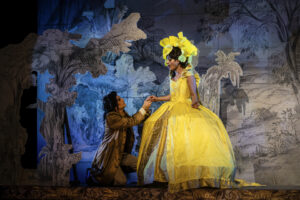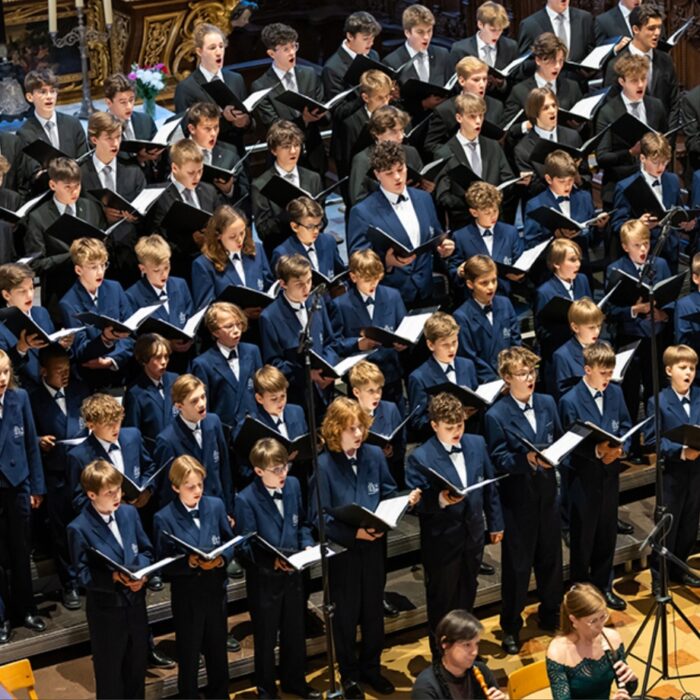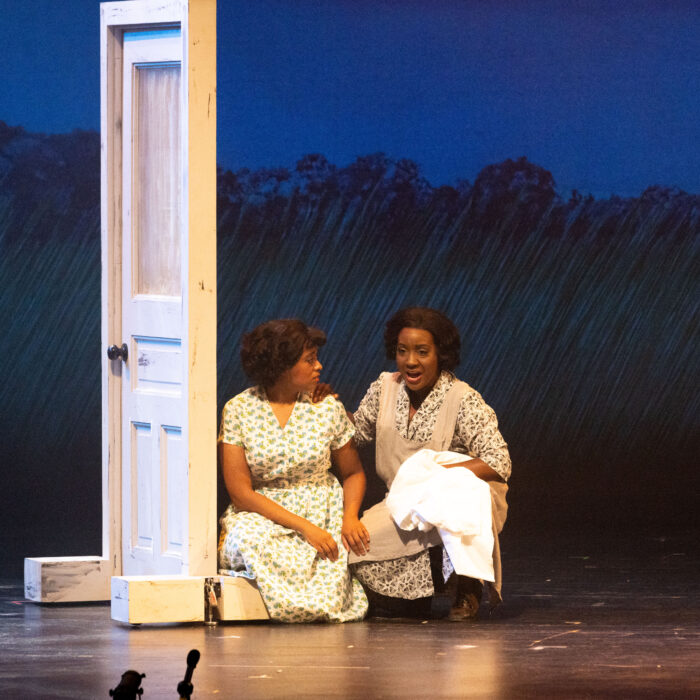
Göttingen International Händel Festival 2024 Review: Sarrasine
An Intriguing Performance from Mariño in the Role of a Castrato
By Alan Neilson(Photo: Alciro Theodoro Da Silva)
The headline event at this year’s Göttingen Händel Festival was the world premiere of “Sarrasine,” a recently constructed opera by the librettist Laurence Dale and the conductor George Petrou, based on the novella of the same name by H. Balzac using music composed by Händel.
A New Pasticcio Using Händel’s Rejected Music
The project originated with Petrou’s interest in the arias and ensemble pieces discarded by the composer during his time spent writing for the theatre. The idea of simply recording the pieces on a disc did not appeal; rather, he wished to present them in the manner in which they were initially intended, that is, on the stage. Hence the collaboration with Dale. Together, they constructed the work around Balzac’s short story, into which they carefully inserted the discarded material, to create a pasticcio, a common form in 18th century opera in which arias from the composer’s and other composers’ works were redeployed in a new work; Händel, himself, often made use of material in this way. And for a festival dedicated to the composer that sets out to explore his creative talents, it is an enterprise that can only be applauded.
The narrative is set in the early years of the 19th century. Balzac is attending a soiree with Madame de Rochefide, for whom he has amorous desires. She has become upset by the smell of death emanating from an old man in a military uniform sitting in the room. Balzac responds by taking her back in time to 18th century Rome, where they meet the young artist Sarrasine, who is in the city to perfect his art, and while there has fallen under the spell of the famous soprano, Zambinella, much to the anger of the opera singer’s patron, Cardinal de Lanty. Although Sarrasine fervently pursues Zambinella, she refuses to succumb and asks him how he would feel if she were not a woman. That evening, Sarrasine finds himself in the Cardinal’s palazzo, where Zambinella, dressed in a military uniform, is performing. Perplexed by her manly attire, he eventually discovers that she is not a she but a he. In fact, a castrato. Grabbing his sword, he appears intent on destroying the statue of the singer that he has carved and even threatens Zambinella herself. Balzac silently moves up behind Sarrasine and kills him. Madame de Rochefide recognizes the military glove she finds on the floor as belonging to the old man she met at the beginning of the opera.
Obviously, many narratives could have been chosen as a means for presenting these arias; however, the choice of Balzac’s “Sarrasine” was inspired, for it allowed the audience to be directly confronted by the central and ambiguous role played by the castrato in 18th century baroque opera, as well as the status they were able to achieve in society. Moreover, with identity dominating political and cultural discourse, the subtext of gender ambiguity could hardly be more relevant.
Sarrasine may be the title of the opera, but it is Zambinella around which the drama rotates, and Dale, who also directed the production, ensured that he was the focal point; almost every time he set foot on stage, the other characters immediately faded into the background. Not only was he given the most flamboyant arias to sing, but he was also costumed in the most ostentatious and colorful dresses and positioned centrally on the stage, with the other characters and the scenery often acting as a framing device. Particularly successful was his use of the side boxes to seat the cardinal and his retinue on one side and the ladies on the other side of the stage, so that they became part of the audience, allowing Zambinbella to have the stage to himself and the audience’s full attention. He was unambiguously presented as a woman for most of the opera. It was only late on, when he appeared in military uniform, that Zambinella was revealed as a castrato and that the ambiguity of his gender took on its significance.
It was also a dramatically clear and engaging presentation that captured the narrative’s momentum. All the characters were well-defined, and their interactions were sensitively presented. Dale’s occasional injections of light comedy to alter the mood, particularly in his presentation of Mademoiselle du Lantry, whose behavior was always somewhat offbeat and bizarre, added the necessary contrast to highlight Sarrasine’s emotional turmoil and enabled the unfolding tragedy to develop in a lively manner. Sarrasine’s statue of Zambinella as an idealized nude woman plays an important role in the drama, and Dale was attentive to its significance, cleverly using it as a reference to Zambinella’s ambiguous gender and sexuality and Sarrasine’s misreading of the situation, as well as a device for connecting the two distinct time periods of the narrative.
Dale was ably supported by Giorgina Germanou’s traditional sets, which, although simple, were colorful and functional and successfully distinguished between the 18th and 19th century scenes. It was her costume designs, however, which she fashioned to reflect the protagonists’ social positions, roles and characters, that really impressed. While this was clearly the case with Zambinella’s wide white dress with feathered headdress and his bright yellow dress with matching head ornamentation, it was equally so for other characters; for example, Balzac was dressed in a fairly boring, sedate costume that reflected his largely unanimated disposition, and Sarrasine was dressed as one would expect of a bohemian artist.
“Sarrasine” includes 15 rejected pieces that Händel initially considered for inclusion in his operas “Tamerlano,” “Agripinna,” “Ottone,” “Floridante,” “Giulio Cesare,” Amadigi di Gaula” and “La Lucrezia,” comprising eight arias, two duets, one chorus, two passages of accompanied recitative, an arioso, and the Embassy symphony (HWV 57), which he rejected from his oratorio “Samson.” Petrou wove these pieces into Dale’s text, along with other numbers from Handel’s operas, instrumental and vocal works, including ten pieces in an alternative form from his operas “Ottone,” “Floridante,” “Alessandro,” “Atlanta,” “Scipione,” “Admeto” and “Alcina.”
Petrou Gives the Baroque a Contemporary Makeover
In part, Petrou structured the pasticcio in the typical baroque form with musical numbers separated by recitatives, although he did give himself a fair degree of leeway, so that frequently an aria was followed by another aria, a duet, or a musical interlude. He also used instrumental numbers more freely than would be considered the norm; his “Concerto grosso op. 6 Nr. 8” was used as a recurring motif, as was his aria “Lascia la Spina” from “Il Trionfo del tempo e del Disinganno” to bind the work together. It proved to be an interesting and fast-moving composition, although, at times, the lack of dry recitatives meant that the music felt as if it were careering forward without the usual balance one would normally expect from an opera by Händel and gave the impression that the inclusion of as much rejected and alternative musical material as possible took precedence over dramatic or formal considerations. Petrou also composed some additional material to support the recitatives, sometimes with a modern twist, with sliding strings and rumbling sounds, which gave the work an eerie feeling. Rather than get distracted by how far “Sarrasine” matches up to other operas of the baroque period, it is more satisfying if viewed as a contemporary work, even if it does rest firmly upon Händel’s music.
Petrou elicited a fine performance from the Festspielorchester Göttingen, which successfully brought out the beauty and emotional content of each of the musical numbers, and although he altered the pace at which the overall composition was delivered to meet the dramatic needs of the narrative, the delicacy and space that would have been brought through the inclusion of more dry recitatives were compromised. His support for the singer and the overall balance of the musical forces were excellent.
Mariño Takes Center Stage
Samuel Mariño produced an intriguing performance as Zambinella. Having a male soprano cast in the role of a castrato definitely brought an extra dimension to the performance, and although he certainly did not possess the physicality of a castrato, who were known to be tall individuals, his petite stature and smooth, refined facial features were perfectly suited to playing a young woman in flamboyant, 18th century dresses. It was also a role in which he appeared very comfortable, especially when positioned center stage, performing directly for the audience. He approached each aria with a carefree theatricality and was not averse to taking risks in order to show off his flashy, dazzling ornamentations, trills and coloratura, even if on occasion they lacked a little precision. His voice is agile, possesses an attractive timbre, and can pop out the high notes with apparent ease. His first contribution was the alternative aria “L’armi implora dal tuo figlio” from Händel’s opera “Alessandro,” which left the audience slightly taken aback, as if it were still trying to process what they were listening to. This was not the case with those that followed; his third aria, “Parolette, vezzi e sguardi,” a piece rejected from “Alcina,” in particular, was met with enthusiastic applause as his exciting and colorful presentation, full of splashy ornamentations, captivated the attention.
Sarrasine was certainly not given a sympathetic portrayal by tenor Juan Sancho. Although he successfully captured the passionate spirit of the artist and allowed his sensitivities full reign, his arduous pursuit of Zambinella bordered on the sexually aggressive. For sure, he pleaded and prostrated himself in front of the singer, but there was always a latent physical dimension that made his behavior unpleasant and threatening. His reaction to his discovery that Zambinella was a castrato was perhaps understandable to a degree, but it did appear that if it were not for Balzac’s intervention, he would have killed him. It was nevertheless a strong performance from Sancho, one that was mirrored by his fine singing, which was forceful, passionate and expressive. He was always fully engaged with the drama and the music, his arias imbued with meaning and emotion. The final scene, which included his rejected aria from “Floridante,” “Amor ed impietá,” and a melodramme based on a rejected accompagnato from “Tamerlano,” was expertly rendered to capture the emotional maelstrom into which he had fallen.
Soprano Myrsini Margariti possesses a pleasing, clear-toned and agile singing voice with a light vibrato, which she used expressively to successfully characterize the role of Madame de Rochefide. Her aria “Tomi la goia in sen,” originally rejected for “Amadigi di Gaula,” allowed her to show off her splendid coloratura, detailed ornamentation and seductive upper register to good effect. While she displayed the required manners and sensitivities of a refined woman of her class, she was not averse to embracing the stereotype and hamming it up for laughs, particularly as she became tipsy and acted out a short drunken scene.
Bass-baritone Sreten Manojlović created a portrait of a fairly laidback Balzac, who was emotionally distant from the action, more content to watch on in a detached, knowing manner. Even his murder of Sarrasine was carried out in slow motion, which further highlighted his emotional detachment; this was not an uncontrolled, hot-blooded reaction brought about by Sarrasine’s attack on Zambinella. The impression was further conveyed by his singing which, although clear, careful and articulate, was at times dramatically flat. There was little passion in his presentation, and he rarely took risks to develop Händel’s arias. In the duet “Tacete, ohimè, tacete!” he struggled to match Margariti, whose emotional strength and ability to embellish and vary the vocal line made it too one-sided. It was only in his final aria, “T’aspetta fuor dell’onde,” in which he took a more confident, assertive approach, that he showed off his quality and captured the full beauty and meaning of the aria.
There were a number of speaking roles. Florian Eppinger made for an authoritative and aggressive Cardinal de Lanty, not averse to dispensing physical violence, and Ronny Thalmeyer was a suitably irritating Viennese fop, who enjoyed tormenting Sarrasine for believing Zambinella was a woman. Marina Lara Poltmann produced a vivacious and amusing Mademoiselle de Lanty, as well as singing in the chorus.
Overall, this was a worthwhile and enjoyable production, and it was fascinating to see Händel’s music presented in such an imaginative manner. Not only did “Sarrasine” prove to be a dramatically strong work, but it was also a well-constructed vehicle for bringing Händel’s rejected music to the stage, notwithstanding the proviso that, on occasion, too many pieces were compressed too closely together, so that individual arias were not always given the necessary space to breathe.



